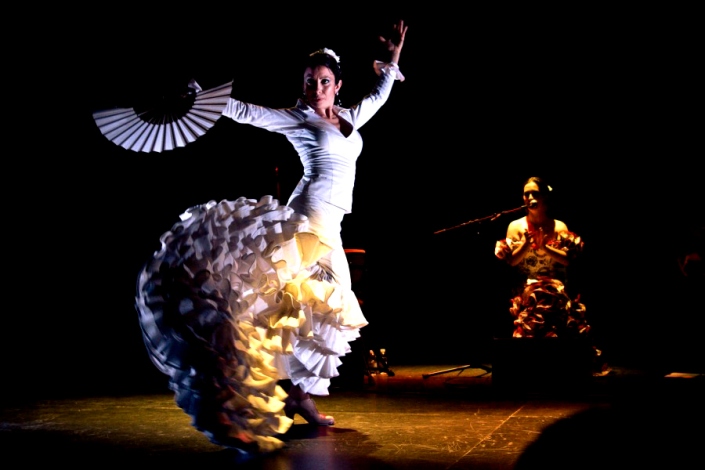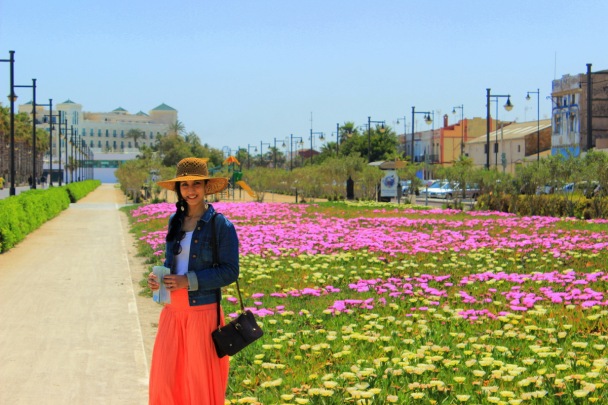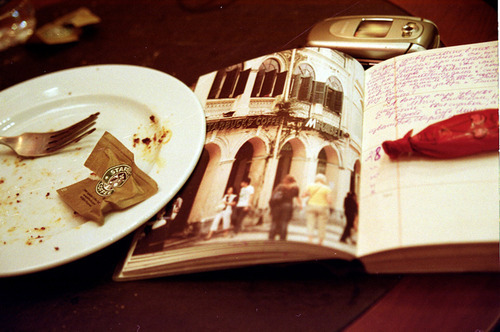Expatriate
12 things this Pakistani girl loves about Spain
Published in Sunday Magazine, September 29th 2014
It’s been a full year since our peregrination to Madrid (hard to believe!), and I think I’ve come a long way from those initial months of confusion, misplaced nostalgia, and sometimes plain despair (among other unproductive emotions that beleaguer you at every move!)
For one, I can (sort of) speak Spanish. I’ve made friends. I even have a (sort of) job! I can navigate the city fairly well – I’ve visited the doctor, the dentist, the real estate agent, the immigration bureau, even the police station (don’t ask), without any major communication disasters occurring. I’ve traveled around the country a fair bit. I’ve been taken for a local and given directions to lost tourists (score!). And, though there are obviously bothersome things about every country, I find myself quite enamored of Spain. Here are just a couple of reasons why, in no particular order!
1. Hot Chocolate
It’s traditional to begin AND end the long Spanish days with a cup of thick, intensely dark hot chocolate, often with a side of churros (long, deep-fried dough pastries for dipping). Some chocolaterías, like the 19th century San Ginés in historic Madrid, are open 24 hours – so you can amble down for an indulgent treat any moment it grabs your fancy. A chocoholic like me can’t complain!
2. Festivals
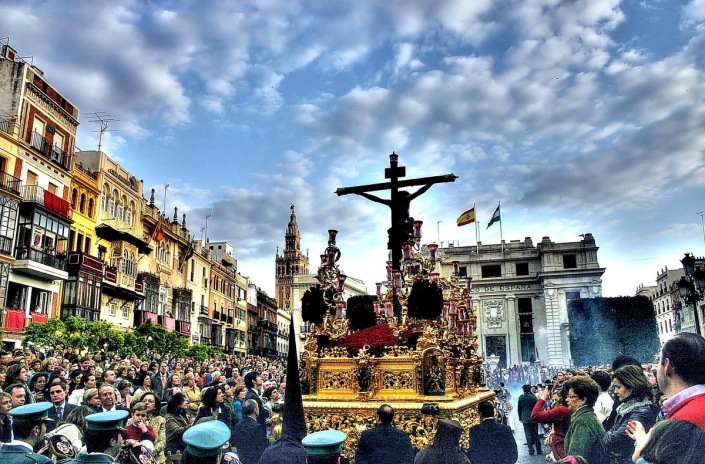
Spain does festivals like nobody’s business, second only to India when it comes to the sheer number of public celebrations and commemorations in the country. The most spectacular among these is Semana Santa or Holy Week (Easter), curiously similar to Ashura in Muslim countries, where participants in full costume re-enact Jesus Christ’s crucifixion and resurrection over the course of 7 days with elaborate floats, music, and in some places, self-flagellation. There are festivals dedicated to saints and to devils, to horses, flowers, geese, tomatoes, bulls, newborn babies, even paper-mache monsters!
3. “Harem Pants”
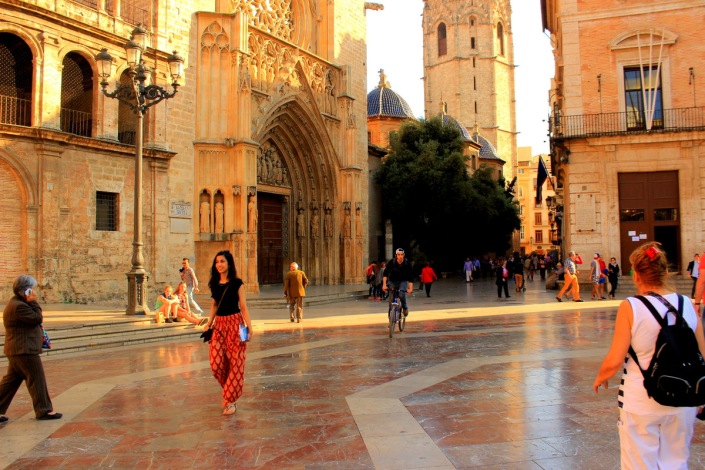
You can literally roll out of bed in a printed shalwar and T-shirt and step onto the streets of Madrid or Barcelona perfectly in sync with fashion. Harem pants, as they are known in the West, are a perennial component of the trendy Spaniard’s wardrobe – the baggier, the better! Could “dressing up” get any easier?
4. Beards & Piercings
Dark-bearded men and nose-studded women are as ubiquitous on the streets of Spain as in Pakistan, partly thanks to hipster trends. So you can comfortably sport your preferred style of facial hair (if you are a man), or a nice twinkly nose piercing (if you are a man or woman), without the least fear of being eyed suspiciously and stereotyped “terrorist”, “punk”, or, most annoyingly, “oh-so-exotic!”.
5. Moorish Spain

Stroll under the Damascene arches of the oldest surviving mosque in Europe, the Mezquita of Cordoba, dating to 785 A.D. Wander through the ethereal Nasirid Palaces of the Alhambra in Granada, the Muslims’ last stronghold in Spain. Treat yourself to a milky Té Pakistani in an evocative tetería. There is an undeniable romance about al-Andalus of yore, and for some romantic reason, you feel as if you share a part of its history.
6. Flamenco
Spain’s most iconic song & dance form has roots in North African and Gypsy (“Roma”) culture. Roma people were originally from the Indian subcontinent, and migrated to Europe about 500 years ago. The mix of cultures produced a unique dance that emphasizes not feminine delicacy and beauty, but feminine power and strength – stomping, sweating, shouting and all! You gotta love it.
7. Olives
Aceitunas have been one of the healthier additions to my diet since moving to Spain. With the cultivation of olives dating to ancient Roman times and improved upon during the Moorish era, Spain today produces about 300 varieties of olives in all shapes, sizes, tastes and textures. Next to my mother’s hand-cured green olives from a family orchard in Pakistan, juicy Spanish olives stuffed with garlic are the yummiest snack I could ask for!
8. Spanish Idiom
Express yourself like a true Pakistani in the Spanish language! From Ojalá (Inshallah), Venga! (Chalo), Que? (Kya?), Hermano (Bhai / Yaar), Adiós! (Khuda Hafiz!) even Ala! (Hai Allah /Allah Tobah!), the flavor of spoken Spanish is remarkably similar to Urdu or Punjabi, with many words derived from Arabic.
9. “Laid back” – in a good way!
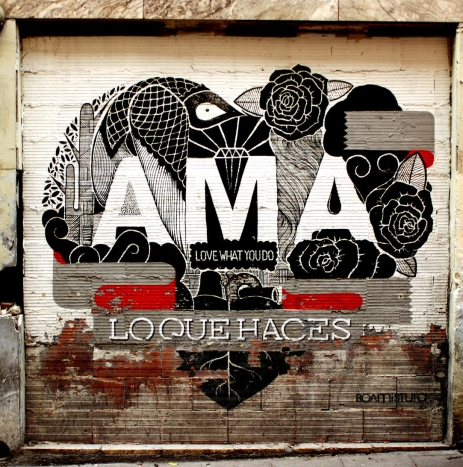
Spaniards have a bit of a reputation for laziness, but from what I see, they work as much as any of their counterparts in the Western world, without the uptight fastidiousness. So, yes, a waiter will probably take 20 minutes to come and take your order, but he or she will also not pester you to pay or vacate your table until you are ready to leave, whenever that may be! Yes, most administrative offices, pharmacies and private businesses take a 3-hour lunch break, but when they serve you, they are always friendly, accommodating, and seem to genuinely enjoy their job, no matter how mundane it may be. I think the system works!
10. Rabo del Toro (Oxtail Stew)
The Spanish version of a Pakistani Aloo Gosht or Nihari – succulent bull or oxtail, slow-cooked in its own stock and a rich gravy of onions, tomatoes, potatoes and other vegetables and spices, till the meat literally falls off the bone. Scoop it up with crusty pieces of bread just like you would do with Naan or Roti back home – riquísimo!
11. Nightlife – Ronaq!
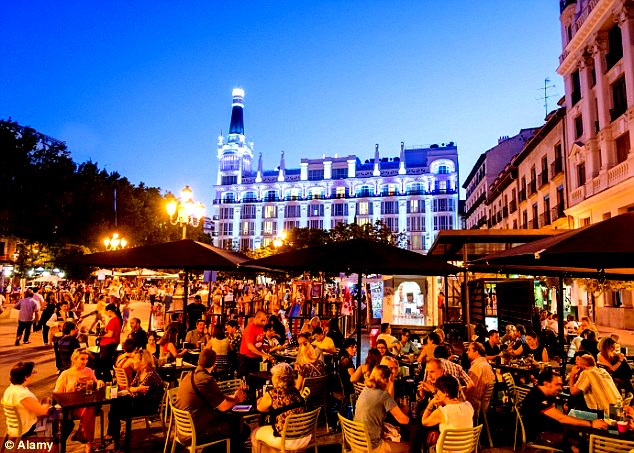
Go for a walk in any barrio or neighborhood in the city center at 1:00 am on a weeknight, and find warmly-lit restaurants and cafes bubbling with customers, street performers juggling fire on the sidewalks, couples strolling along with little children in tow, boisterous touts trying to lure you into nightclubs. And the weekends? Soundproof windows recommended if you want to get any sleep! No matter the unemployment and fiscal crisis, the Spaniards know how to have a good time.
12. Compliments!
In most places in the world, being addressed as “pretty girl” (guapa), “little girl” (niña), or “queen” (reina) by a complete stranger would be considered offensive, and probably make you uncomfortable. Not in Spain! Shopkeepers, street vendors, waiters, passersby, men and women can call you all those things in Spanish without a trace of sleaziness. Now why wouldn’t that make you feel good? Add to that their beaming smiles and ready greetings, it’s impossible not to feel happy and welcome in this country.
“How to Make Friends in a New City” – Published on BootsnAll!
Dear readers,
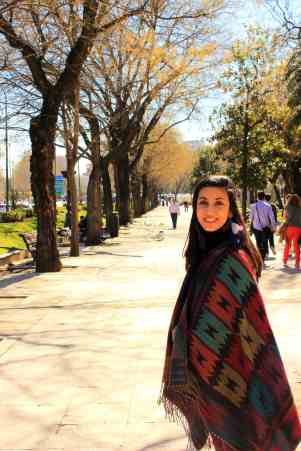
My recent series of blogposts, recounting my (mis)adventures as a fresh-off-the-boat expat in the splendid Spanish capital of Madrid, was published today as a feature article on BootsnAll, the largest and most popular online resource for independent travelers! Of course, I’m muy excited about it, and would love for you to read and share the article with your friends!
How to Make Friends in a Foreign City – Essential Tips from a Nueva Madrileña
And thanks as always for your patience with my protracted disappearances. I’ve been up to many things, and I’ll recount them to you in due time :)
Abrazos from Madrid,
Manal
How to Make Friends in a New City – Tip #5
- No te preocupes! Don’t worry! Let the universe do its thing!
This is something I’ve learnt along the course of my somewhat peripatetic life the past 6 years: sometimes, people (and opportunities) fall into your lap in the most unexpected, unlooked for way; and these congenial little windfalls may be the best things that happen to you in your new home.
I remember a certain day in Ithaca, New York, where Z and I had moved right after getting married. Z was in class at Cornell, and I was busy cleaning, unpacking and ‘nesting’ in our new apartment, a ground-floor portion of a typical East Coast colonial house, when our gritty old landlord Carl ambled up to the front door, dressed in his customary red plaid shirt and classic blue jeans. “Hey there!” Carl hollered, “I wanted to introduce you to these nice folks,” he gestured towards the smiling young couple that followed him. “They’ve just moved to Ithaca from Mexico, and are thinking of renting from me as well!”
That was the first time I met Elsa & Silvano. Though we only spoke for five minutes, standing in the porch of Carl’s yellow-painted dollhouse, and thought they didn’t end up renting from him after all, they became our closest companions the 9 months we spent in Ithaca, and we still count them among our dearest friends.
So, just like that, someone may chance to cross your path, and you’ll hit it off with them like you never imagined. Maybe a friend of a friend puts you in touch with somebody they know who happens to live in the same city; and you turn out to be kindred spirits, Anne of Green Gables-style. Or maybe another like-minded soul, going through the same experiences as you, discovers you and contacts you through your blog!
I find it so interesting, how these connections are made – magically, almost – bringing complete strangers together through no deliberated effort. So, if you ever find yourself lost, alone and friendless in a new city, wondering why on God’s earth you ever transplanted yourself in the first place: don’t worry! It takes time for a plant to adjust to new soil, a new atmosphere. But once it gets over the wilting, drooping, moping period – ‘transplant shock’ in botanical terms – it thrives. In fact, if you don’t keep an eye, it may even start merrily taking over your garden, and you won’t know what to do! :)
Happy New Year from Madrid! Here are some photos we’ve taken of the city’s squares, streets and public spaces.
Read Tip #1,Tip #2, Tip #3, Tip #4, and the introductory post of this series!
How to Make Friends in a New City – Tip #4
- LANGUAGE EXCHANGE
Language exchange, or intercambio, is a popular (and free) method of learning languages in Spain. There was a plethora, a veritable sea of Spaniards out there, my Spanish teacher told me, who were desperate to find a sympathetic English-speaker to practice their hesitant conversational skills with. English is taught in Spanish schools as an optional second language, but in the most pedantic way possible, so that somebody who has “studied” English for over 10 years can barely formulate a coherent reply to a “Hi, what’s up?”
Kind of like how we were taught Pakistan History in secondary school. Once, in a surprise test, the teacher asked us to write an essay comparing the achievements and successes of two of Pakistan’s Prime Ministers. I started with the conventional introduction (memorized from the textbook, of course), ended with the conventional conclusion (we knew it like we knew our multiplication tables), and filled in the middle with a fictitious story, sprinkled with song lyrics. The result? 9/10, if you please, and a “Well Done!”
But, coming back to Spain – intercambio sounded like the perfect arrangement for me. Not only would it help my Spanish, I would also have somebody to chat with over a cup of coffee – that nameless, shadowy, friend-like figure I wanted so badly in Madrid! All I had to do was find somebody…
I immediately set to work. I went to tusclasesparticulares.com, created a profile, and posted an anuncio, an ad, stating my particulars in a cheerful, casual tone, and offering my stupendous English-speaking ability in exchange for un poco ayuda with my abysmal Spanish. We could meet in a cafe, or a park, como tu prefieres. I enjoyed photography, and writing, and meeting new people. Hoped to hear from you soon!
It almost felt like online dating, or shaadi.com. I went to bed that night with a flutter of excitement in my heart. Who would read my ad? Who would reply? Would I like them?
But nothing could have prepared me for the deluge of emails I found in my inbox the next morning; messages from men and women of all ages, all walks of life, from the city of Madrid and beyond, asking for my hand as their intercambio partner.
I was terribly flattered – and a bit overwhelmed. There were just too many fish in the sea. I needed to focus, start being selective, separate the wheat from the chaff, as they say. So began Step 2 of the intercambio-partner-hunt: carefully reading every ‘applicant’s’ email to divine something about their personality (Does she sound too serious? Does he sound sleazy?), stalking them on Facebook and Twitter, examining any photos that turned up. Some applications were discarded immediately; for example, the 38 year-old pianist who sent me a tea-stained studio portrait of himself in a brown fedora and brown tweed suit, or the 18-year old Economics student whose entire album of Facebook profile pictures consisted of duck-faced selfies.
After I had completed the first shortlist, I sent an email to each selected ‘applicant’, requesting, somewhat discreetly, a 200-word personal statement: “So, what do you do? What have you studied? What are your hobbies? I think it’s important, for a successful intercambio, that we share some interests, don’t you agree?”
When the replies started coming in, I made a second shortlist. Emails that included the words “books”, “languages”, “cinema”, “outdoors”, “museums” and “dogs”, for instance, were directed to the “Yes” Folder, while emails with the words “motorbikes”, “shopping”, “clubbing” and “pop music” were immediately relegated to the “Rejects” Folder (no offense meant to motorbike aficionados, shopaholics and Katy Perry fans, it’s just that, I wouldn’t know what to say to you!).
Now came the hard part: the actual, face-to-face meeting! I made appointments with the final 10 candidates, to meet them at a public square or coffee shop – blind dates, really. We barely had any idea of what the other person even looked like. And anyone who has been on a blind date will know that the first meeting was absolutely crucial. It could make or break the budding relationship. Either you liked the person, or you didn’t. Either you wanted to see that person again, or you didn’t.
Sure, I had my share of disappointing dates. Some people, intimidatingly interesting on paper, were plain boring in real life. Some people lacked energy or enthusiasm (for which I always tended to overcompensate, resulting in the peculiar condition know as the “laughing headache”), and some people just didn’t speak. In these cases, I found silence to be the best way to politely “end” things. In other cases, I was forced to lie: “I’m sorry, I’ve found a job as a dogwalker and don’t have time to do intercambio anymore!”
But, with some people, it just clicked. Conversation flowed naturally, there was laughter on both sides, and you were perfectly at ease after the first five minutes. I met a medley of memorable characters – a lawyer, a psychologist, a biochemist, an astrophysicist – all more or less my age, warm, openminded, hardworking people from different parts of Spain, who somehow found time to meet me for intercambio in their 10-hour work days. Finally, I could stop! Stop the endless virtual interviews, the awkward blind dates, the cruel but inevitable rejections!
So, has language exchange made me fluent in Spanish? No. Has my Spanish improved? I’d like to think so, yes. But more importantly, I’ve found Spanish friends, and through them, an insight into Spain. They tell me their views on love, marriage, family, religion, politics, and I share with them my experiences growing up in Pakistan and living in the United States, two completely different worlds about which they are equally curious. It’s strange how two people, complete strangers in one moment, can go to speaking about their personal lives with the air of old friends in the next. It is something that happens always with expats – maybe out of the boldness that comes with being a foreigner, or maybe out of our intrinsic need to trust, to talk, to confide in a palpable human being, in a place where there are no givens, where we must build our life up from the ground.
Read Tip #1,Tip #2, Tip #3, Tip #5, and the introductory post of this series!How to Make Friends in a New City – Tip #2
- JOIN A RECREATIONAL CLASS
When you’re not a full-time student, nor do you have a “’real” job, nor any family in the city where you live, you end up with a lot of free time on your hands – which can be perfectly utilized by learning something you’ve always wanted, but never really got a chance to do. For instance, crocheting, or Thai kickboxing. Sushi-making, or calligraphy, ventriloquism, or, better yet, magic!

That something for me right now is Middle Eastern dancing. I carry my black coin-belt around with me wherever we go, and Google down a dance class whichever city we happen to be in. Apart from the fact that I love to do it, it’s also a good way of meeting people – perhaps even a potential friend, whom you are assured of having at least one thing in common with!
So, with all this in mind, I joined a classical Egyptian dance class in Madrid, taught by a half-Egyptian, half-Paraguayan, Spanish-born woman called Yasmina, who has been dancing professionally for 20 years.
On my first day, I arrived late. I had gotten confused when exiting the metro station, and walked in the wrong direction for a good ten minutes. “Darn it,” I thought, when I realized my (usual) mistake. “There’s no point of going to the class now. There won’t be space for me anyway!”
I was envisaging, of course, the type of dance classes I had attended in Berkeley and New York; a normally tiny square-shaped room packed to the seams with a variety of serious-faced girls in intimidating-looking leotards; the teacher (whom you could barely see) hollering instructions, bootcamp-style, over the pounding music; and me in the back row, whacking my hands into the wall every time we did snake arms, or getting trampled on by Rubber Girl next to me at every grapevine turn.
But here, when I scrambled into class, huffing and puffing, with a “Lo siento-ooo!”, I’m sorry-yyy, on my lips, I was shocked to find myself in a 60 ft x 30 ft, hardwood-floored room, glistening mirrors on not one but three sides, nicely framed posters on the cool blue walls, and Yasmina the teacher with two students – dressed in comfy track pants and T-shirts – quietly doing some stretches.
“Is the class already over?? Has everybody left??” I asked, bewildered.
No, they were just about to start! “Solo nosotras,” Yasmina smiled, flicking on the music. I couldn’t believe it! What joy! What pleasure! What a wonderful feeling to sway about freely my unusually long limbs without colliding into an animate or inanimate object at every move!
There were even times when the other two students didn’t show up, and it was just me and the teacher, whom I could pester with complaints and questions to my heart’s content (“But why can’t I do the sideways shimmy? Why? Why doesn’t it look as good as yours?”) On the downside, nobody in the class, including the teacher, spoke any English, so we had to suffice in our communication with gestures, intonation and a range of facial expressions. The other girl in the class, who was my age, seemed nice, but I could not glean much about her from my limited Spanish and her non-existent English save that she worked at a pharmacy, loved leopard print and Khaled.

On the upside, one of the first things I mastered in the Spanish language were parts parts of the body – rodilla, tobillo, talón, cadera, codo, muñeca, cuello – much to my Spanish teacher’s amazement when we came to study that chapter in class. You bet, I knew them body parts like a doctor. And, generally, I became known amongst the nice ladies at the dance school as the funny “American” girl (because I spoke English) who laughed a lot, seemed genuinely excited to be in Spain (unlike the Spaniards themselves, who were desperate to leave), and who continually invented new ways to bungle their language – which they didn’t seem to mind at all!
Read Tip #1, Tip #3, Tip #4, Tip #5, and the introductory post of this series!
How to Make Friends in a New City – Tip #1
- JOIN A LANGUAGE SCHOOL
Now, this may seem like an obvious thing to do if you move to a country where you don’t speak the local language (and no, ordering a burger or asking where the bathroom is does not count), especially if you plan to stay there for a couple of months or more.
But many expats and immigrants, particularly from my “brown” part of the world, prefer to muddle through daily life with vernacular scraps, picked up in various situations and locations, and, needless to say, grammatically atrocious. Coupled with histrionic gestures and deliberately choppy English, they manage to make themselves almost perfectly understood, albeit in a primitive, cave-man sort of way. “I-go-mercado, para shopping.” “This-seat-libre, por favor?” “Me gusta this movie. It is muy bien.” “Tiene scissors, chop-chop?”
The real barrier, though, is the cost of learning a language. Well-reputed language schools promise you many grand things – “Speak Spanish like a native in just six weeks! Three months to your dream job as a parasailing instructor in sun-filled Majorca! Looking for love in Spain? Let us teach you the language of loveee!” But they also require you to dig deep into your pockets for the bargain, which most immigrants cannot afford to do.
However, thanks to my avid habit of reading advertisements in the metro (and everywhere else), I came across a language school that was reasonably-priced, and only a five-minute walk from where we lived, near Puerta del Sol. Upon investigation, I discovered that C.E.E. Idiomas was indeed a legitimate language school, complete with an administrative office, three stories of classrooms, and plenty of bright-faced, noisy internationals crowding its narrow staircases – and not, as I had initially suspected, some sinister racket for trapping gullible foreigners on shoestring budgets.
My first day of class I was terribly excited. I’ve always been a bit of a nerd, and loved going to school as a kid. So, I picked out a crisp new Generation kurti, slipped on my favorite orange flats, tossed a purple notebook and Piano pen into my Democracy Now tote bag, and set off bouncing along to class. I wasn’t only going to learn Spanish. Nobody knew it, but I had other intentions. I was friend-hunting.
Unfortunately, my dream of finding a kindred spirit, sitting there waiting for me in the classroom – darkish hair, fairly tall, not unlike myself, whom I would then proceed to hug, and demand, “Where have you been all this time???” – did not quite materialize. None of the students were the right fit. Some were too old (grandmother), some were too young (just out of high school), some had too many responsibilities (committed housewife, mother of two school-goers), and some were just too foreign (Kentucky, USA?). There was only so much we could share or talk about.
But still, peeling off my pajamas and going to class everyday in the fresh morning air, interacting with corporal human beings apart from my husband and the Carrefour lady was admittedly very pleasant. Plus, our Spanish teacher was an absolute riot, and we spent most of the hour laughing, though we didn’t understand half of what she said. I was learning quite a lot, too, very useful and practical things (for example, the important distinction between ojo, eye, and ajo, garlic, which I had confused more than once at the grocery store: “Tiene salsa de ojo?” “Do you have eye sauce?”). And – how can I deny it – I loved being back in ‘school’!






